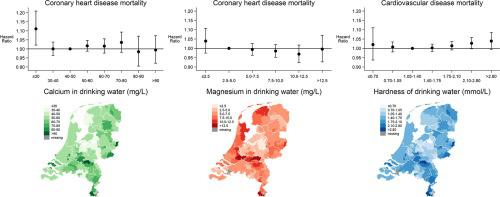Environment International ( IF 10.3 ) Pub Date : 2022-06-17 , DOI: 10.1016/j.envint.2022.107356 Danny Houthuijs 1 , Oscar R P Breugelmans 1 , Kirsten A Baken 2 , Rosa M A Sjerps 2 , Maarten Schipper 1 , Monique van der Aa 1 , Annemarie P van Wezel 2

|
Background
Although drinking water in the Netherlands is generally accepted as safe, public concern about health risks of long-term intake still exist.
Objective
The aim was to explore associations between drinking water quality for nitrate, water hardness, calcium and magnesium and causes-of-death as related to cardiovascular diseases amongst which coronary heart disease and colorectal cancer.
Methods
We used national administrative databases on cause-specific mortality, personal characteristics, residential history, social economic indicators, air quality and drinking water quality for parameters specified by the EU Drinking Water Directive. We put together a cohort of 6,998,623 persons who were at least 30 years old on January 1, 2008 and lived for at least five years on the same address. The average drinking water concentration over 2000–2010 at the production stations were used as exposure indicators. We applied age stratified Cox proportional hazards models.
Results
Magnesium was associated with a reduced risk for mortality due to coronary heart diseases: HR of 0.95 (95% CI: 0.90, 0.99) per 10 mg/L increase. For mortality due to cardiovascular diseases, a 100 mg/L increase in calcium was associated with a HR of 1.08 (95% CI: 1.03, 1.13) and an increase of 2.5 mmol/L of water hardness with a HR of 1.06 (95% CI: 1.01, 1.10). The results show an elevated risk for coronary heart disease mortality at calcium concentrations below 30 mg/L, but over the whole exposure range no exposure response relation was observed. For other combinations of drinking water quality parameters and cause-specific mortality studied, no statistical significant associations were identified.
Conclusion
We identified in this explorative study a protective effect of magnesium for the risk of mortality to coronary heart disease. Also we found an increased risk of mortality due to cardiovascular disease associated with the concentration of calcium and the water hardness in drinking water.
中文翻译:

使用全国暴露和死亡率数据评估荷兰的饮用水安全
背景
尽管荷兰的饮用水被普遍认为是安全的,但公众对长期饮用健康风险的担忧仍然存在。
客观的
目的是探讨饮用水中硝酸盐、水硬度、钙和镁的水质与心血管疾病(其中包括冠心病和结直肠癌)相关的死亡原因之间的关系。
方法
我们使用了有关特定原因死亡率、个人特征、居住史、社会经济指标、空气质量和饮用水质量的国家行政数据库,以符合欧盟饮用水指令规定的参数。我们收集了 6,998,623 名在 2008 年 1 月 1 日年满 30 岁且在同一地址居住至少五年的人。采用生产站2000-2010年平均饮用水浓度作为暴露指标。我们应用年龄分层 Cox 比例风险模型。
结果
镁与冠心病死亡风险降低相关:每增加 10 mg/L,HR 为 0.95(95% CI:0.90,0.99)。对于心血管疾病引起的死亡率,钙含量每增加 100 mg/L,HR 为 1.08(95% CI:1.03,1.13);水硬度增加 2.5 mmol/L,HR 为 1.06(95% CI)。 CI:1.01、1.10)。结果显示,钙浓度低于 30 mg/L 时,冠心病死亡风险升高,但在整个暴露范围内,没有观察到暴露反应关系。对于所研究的饮用水质量参数和特定原因死亡率的其他组合,没有发现统计上显着的关联。
结论
我们在这项探索性研究中确定了镁对冠心病死亡风险的保护作用。我们还发现,由于心血管疾病导致的死亡风险增加,这与饮用水中的钙浓度和水硬度有关。











































 京公网安备 11010802027423号
京公网安备 11010802027423号